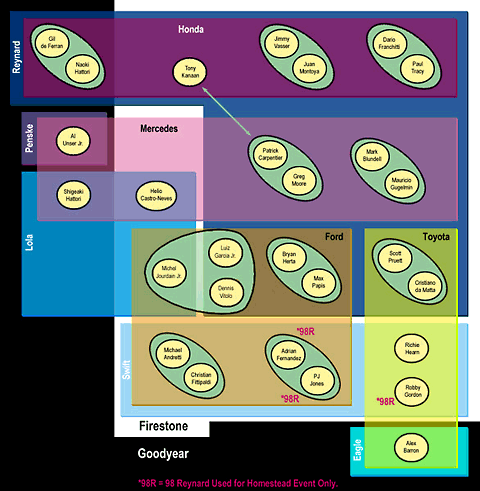In a sport where the difference between winning and losing can be measured in fractions of a second, the racecar driver is always seeking a unique competitive edge. And yet, as the technology of CART becomes ever more complex, sometimes that edge can be gained through open collaboration rather than tight-lipped competition.
As any armchair computer simulator racer can attest, finding the right setup for today's Champ cars can be maddeningly elusive. The number of variables is huge, and there is a limited amount of time to test the endless possible combinations.
Whereas each team in Formula One fields a proprietary chassis, CART teams purchase their equipment from a common group of third-party vendors. Since virtually every aspect of the car's performance can be continuously documented via computer telemetry, the potential gains of data sharing amongst drivers, teams and manufacturers are enormous: why waste valuable practice time testing a certain setup when someone else has already proven it to be ineffective?
To illustrate the opportunities for data sharing, we introduce to champcar.com the Speedcenter Shared Info Chart. This chart makes clear how certain teams have a wealth of data sharing opportunities, and other teams have very few. Although the chart shows all three elements of each driver's package, bear in mind that CART engines are owned and maintained by their manufacturers, so the performance of a particular engine is relatively constant across teams.

Let's start by looking at the most isolated drivers, Al Unser Jr. and Alex Barron. Each driver is part of a one car team, and each is running a chassis unique to the field. When Unser is having difficulty with his qualifying setup, he has no teammate to ask for advice, and the manufacturer of his chassis, Penske, cannot compare Unser's setup with that of another customer. Likewise, the interaction between Alex Barron's Eagle chassis and his Goodyear tires cannot be judged against the setup of another driver, since Barron is the only driver using that particular combination. Neither of these two drivers qualified well at Homestead: Unser qualified 14th and Barron 23rd.
On the opposite end of the spectrum, consider the three Forsythe drivers, Greg Moore, Patrick Carpentier, and Tony Kanaan. If they and their mechanics are willing to pool data, their three-car effort has the potential to explore more possible combinations of Reynard-Firestone setups during practice than any other team. The Homestead television broadcast confirmed that the three drivers were indeed sharing information; however, the Mercedes-Reynard-Firestones of Moore and Carpentier were quick all weekend, while Kanaan's Honda-Reynard Firestone was not.
Kanaan's troubles aside, The Reynard-Firestone combination looks very strong after the first race of the season, holding seven of the top ten qualifying spots, running nine of the top ten fastest laps of the race, and finishing with seven of the top ten. With thirteen drivers running the Reynard-Firestone package, the two manufacturers should have a wealth of data with which to improve their products as the season progresses. Perhaps that's why the Reynard-Firestone combination has won the last three championships and 29 of the last 31 races.
Of course, predicting equipment performance by data-sharing potential has its flaws. For one, variation in driving style can reduce the utility of shared setups. Two seasons ago, defending champion Jimmy Vasser suffered greatly when the Ganassi team ordered him to use his teammate Alex Zanardi's setups, and his performance improved the following year when he was permitted to seek out his own most favorable setup.
The controversy surrounding this year's Swift chassis illustrates the value of keeping some knowledge to yourself. While the Patrick and Gordon teams struggled with their new Swifts in the preseason and decided to use the '98 Reynard chassis for the first two races, Newman-Haas ran the new Swift at Homestead with excellent results. Michael Andretti qualified fifth in his Swift-Firestone and came in second in the race. Have the Newman-Haas mechanics gained some special knowledge from their two years of exclusive experience with the chassis? Is owner Carl Haas able to leverage his position as Swift's exclusive distributor to get a sneak preview of experimental parts? Are there top-secret aspects of the Newman Haas setup that are unknown to Swift and Firestone, and therefore unavailable to the other Swift teams?
Another driver succeeding at Homestead without the benefit of data sharing was Helio Castro-Neves, who qualified his Lola-Firestone in fourth position, and ran the second-fastest lap of the race. Michel Jourdain Jr, the only other Lola-Firestone driver, was not nearly as quick, his fastest lap almost a full second slower than Helio's fastest. Again, perhaps Helio's one-car Hogan team has independently discovered the Lola sweet-spot, and Jourdain's team may have to find it on their own.
Can the Hogan team keep their Lola-Firestone competitive as each passing race creates a growing pool of Reynard-Firestone data? We'll be keeping an eye on these developments throughout the season, lighting up the driver circles in green, yellow and red to tease out trends in equipment performance. If a "hot package" emerges, the chart will help explain the possible contribution of data sharing to that package's success.
chart © 1999 Jeff Pucillo